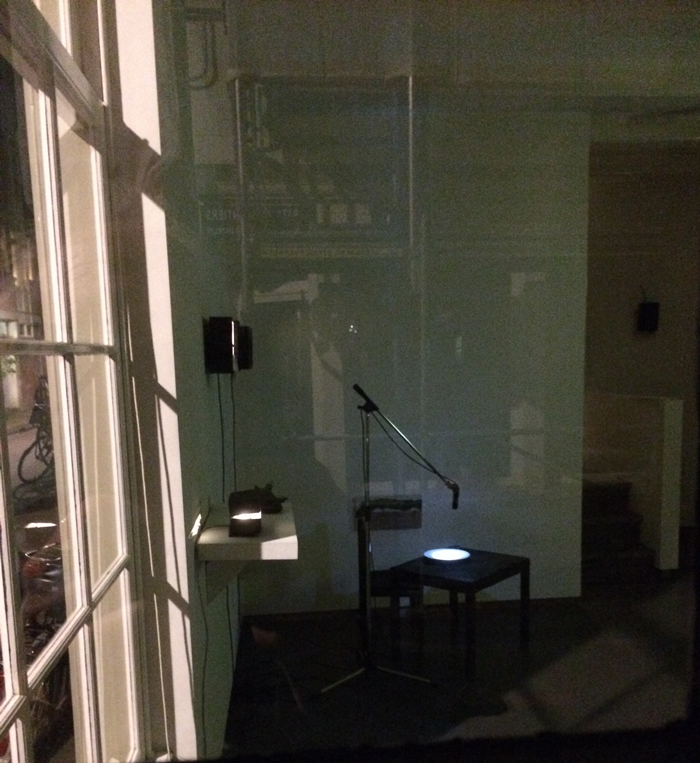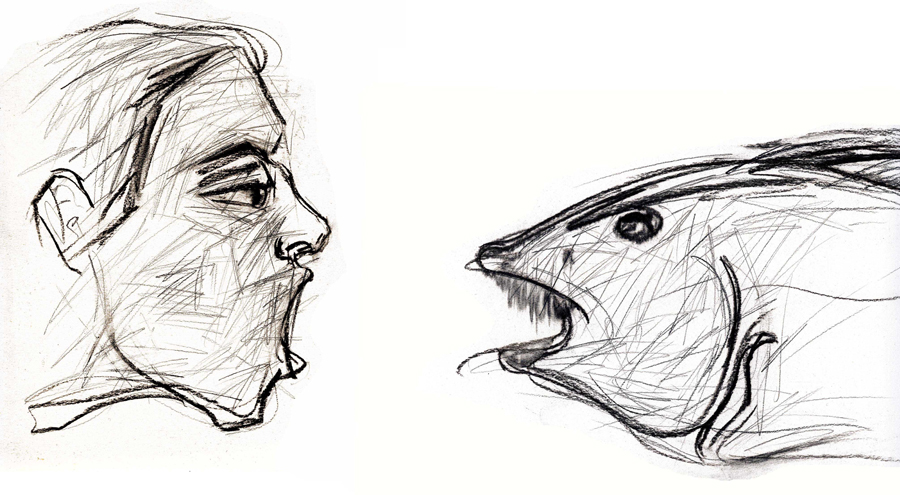
My ideas are born while working, and my ideas take shape while working. It is an interplay between head and hands. It is a form of thinking out loud. Coincidence plays a big role. The work arises through “playing”. For me, it is essential to arrive at a visual meaning without logic or language. You play with ambivalent, irrational and uncertain elements. It is also the truth of the absurd that fascinates me. I give most of my works a title. Not to explain them but to add a literary element that helps thinking about a work. It is a dialogue with myself. Most of my work balances in the twilight zone between abstraction and figuration.. In 2018, the German critic Larissa Kikol wrote; “The objects are metaphors from which you can derive the themes of his work: falling, burning, being injured and loneliness.”
I am a narrative painter. Not narrative in the sense of an anecdote, but narrative about a subject that I usually research for a few years.
Some paintings from the period 2004-2013 could be seen as an unconscious attempt to represent loneliness. Emptiness and barrenness were constructed by distorting perspective, the use of colour and compositional interventions. The subjects are diverse.
Everything I say about my visual work falls short. It would be rationalisation after the fact. What really led to certain choices is also a mystery to me. In some works, the literary source is vaguely visible. There are some key works such as The Anatomy of Silence and Round the Corner of Buster Keaton. A characteristic of many works is emptiness, barrenness, silence. What interests me is the human drama. The mystery of it. Beauty, but also horror, is experienced in the mind.
2023's new paintings are landscape-based with a high degree of abstraction and utter disregard for any form of realism. It's only about painting now. A playground.
I have made objects, sculptures, installations, paintings, drawings, gouaches, interior designs, filmed adaptations of theatre performances for television, directed dance theatre performances, designed decors and written articles about visual arts and dance.
I feel an affinity with the conceptualists. Because of the use of different media and manifestations, but mainly because it is the art of the idea. What appeals to me is the artistic freedom of poet Fernando Pessoa, who chose a separate form for poems of different kinds and, as an ultimate consequence, even a different author’s name. My intentions and moods vary, resulting in a variety of subjects and themes. And as a consequence, I use different styles. My work can be seen as the result of the search for the right form to express a subject. Form is the essential carrier of content. “I am disclosing my fantasy”, said Ger van Elk, when I asked him how he sees his work. His statement describes how I see the work of an artist. However different the works from the various periods may seem, there are also many connecting aspects. I usually abstract the form. In recent years, my work has been more sketchy and ‘rough’. The borderland between figuration and abstraction has always fascinated me.
Many paintings from the period 2004-2013 and the new paintings from 2023 are figurative works made with abstract principles. After all, as a contemporary artist you are steeped in both figurative and abstract art. Both influence you. But also music, literature, film and photography. The subject is often of secondary importance. It often acts as a starter to get the imagination going. Especially the way in which you paint something -the form- plays a decisive role in creating the meaning of a work. So the colour and the skin of a painting play a dominant role. I avoid perfection. Life is not perfect either. Usually messy, unpredictable and painful. But nevertheless, I look for beauty in the authenticity of materials and composition. I choose materials for their metaphorical value and the meanings they evoke.
In the nineties, I made a.o. A man alone is in bad company and Naast. Television adaptations of avant-garde theatre performances. This website only contains a selection of my visual work. From 2018-2022 I only did black and white objects.
In 2023 I started painting again but I also created many objects. The objects are different of style, form and content than my paintings and it is like two languages. Visual bilingualism.
The layout of this website suggests that the paintings, objects and designs came about one after the other. The opposite is the case. Painting, objects, designing and writing influence and feed each other. Robert Broekhuis, 2023
LOOKING AT THE WORLD AS A PAINTER
"...The movement that Robert Broekhuis himself brings about in his paintings is that of free fall, a weightless turning point in existence. He makes it possible for you to imagine this, even in paintings that lack the human figure. They offer you the freedom to imagine something that is absent in the painting. The work of Robert Broekhuis always shows an in-between space, the so-called liminal space that automatically transports you from one situation to another. A liminal space is always a transitional area where you stay for a short time, a landing, a corridor, a space revealed by an upright window or ajar door. It is the threshold of consciousness, the space between conjecture and knowing, between outside and inside, the imaginary space of a stair step that you miss when you stumble. Man then has an imperfect presence..." Alex de Vries, 2019
L'ANATOMIE DU SILENCE
Les œuvres des artistes traitent de la contradiction paradoxale de la simultanéité de la beauté et de la violence. Comme des métaphores sculpturales de la douleur et de la rédemption, du chagrin et du réconfort. Il semble aussi être un jeu entre les rêves et les rituels. Il utilise des matériaux comme le goudron, le bois brûlé, la pierre, la laine d'acier, la corde, le fer et les branches. Il existe une affinité avec l'Arte Povere, mais aussi avec l'art conceptuel : l'ombre d'une œuvre joue un rôle important. Le jeu avec la gravité. Qu'en est-il des lois d'Isaac Newton ? Il y a des œuvres qui demandent presque si on peut rire et pleurer en même temps. Il s'intéresse à la "musique" des œuvres. Et la peau et la physicalité d'une œuvre. La poésie des choses ordinaires et quotidiennes et l'équilibre précaire entre la beauté et le contenu.
Charlotte Bergmann, 2019
BLACK BOX
The artist uses objects and materials unlike the abstracts just because of their meaning. The route we take within his work is intimate and an exceptional form of communicating the unspeakable. Outside the abstract aspect of his work and the 'musical' part, we interpret. Conscious of the language of things, of the poetry of space, he builds up series of associations that create a space of experience. In the end, the work of art guides us through the maker's fairway. The artist seems to end his journeys with beauty as eternal comfort for loss and desire. Treacherous though, because on closer look he uses aesthetics to entice spectators to consider his work in more depth. And then they turn out to be metaphors for loss, destruction and cruelty. In spite of this his work shows also a zest for life and humour ... His work can be regarded as an investigation into the human condition and the vulnerable state in which we humans find ourselves. Maurice van Tellingen, 2018
FROM AN INTERVIEW
‘My work is ambiguous. There are always unconscious factors that lead to a certain conception. Afterwards one can say: 'It's a good work'. But what is good about a work, you don't really know. Therefore, interpreting a work is a rationalisation in retrospect. ‘
NOTES / MOTTO
“... only in the world of fantasy is freedom"
Gustave Flaubert, quote from a letter to Louise Colet, 16 May 1852
‘We don't see the things as they are, we see them as we are.’ Anaïs Nin
NOTHING IS ABSURD FOR THOSE WHO FLY
You hear someone laughing and someone else crying heartbreakingly. What do you experience? You can't laugh and cry at the same time. But as an artist, you can show every contrast. As the Italian futurist Bruno Munari showed with his photo collage: Nothing is absurd for those who fly. (1930)
STORIES STORIES STORIES
Humans are storytelling creatures. When Hannah Arendt was asked "Who are you", she replied:"Allow me to tell a story." Who we are is impossible to understand without the story of our live, writes Arendt in Between Past and Future.
We arrange our lives on the basis of stories we hardly know.
LES RÊVES VIGILES
Après tant d'années, le rêve, pour moi, s'échoue encore un désir insatisfait de mouvement, de mouvements intenses, excessifs, et me laisse vivre surtout dans les gestes, dans les rythmes, dans les actes. Henry Michaud, Les Rêves vigiles, 1969
FRIEDRICH SCHILLER
Die Aussprache des Dichters, Dramatikers und Philosophen
Friedrich Schiller ist vielleicht der wichtigste Ausgangspunkt: ‘ Der Mensch spielt nur, wo er in voller Bedeutung des Worts Mensch ist, und er ist nur
da ganz Mensch, wo er spielt.'
MENSCH UND FISCH
Late one night I was walking on Boulevard Saint Germain in Paris.
I passed a restaurant. It was closed and dark inside. In the windowsill stood a fishbowl, with one lonely fish swimming in it.
I talked a bit to him. To cheer him up. I should have known fish don’t care about humans. So in the end I shouted :’Stupid fish’ to him. Went home and made this drawing.
